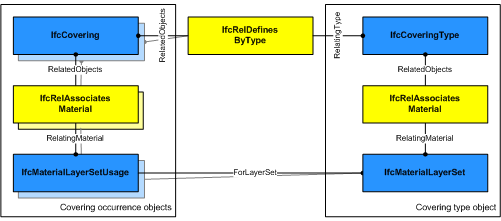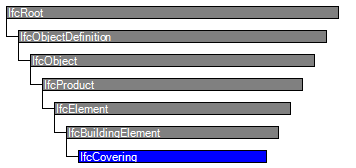Semantic definitions at the entity
Entity definition
Definition from ISO 6707-1:1989: term used: Finishing - final coverings and treatments of surfaces and their intersections.
A covering is an element which covers some part of another element and is fully dependent on that other element. The IfcCovering defines the occurrence of a covering type, that (if given) is expressed by the IfcCoveringType.
EXAMPLEs include wall claddings, floorings and suspended ceilings as well as finish trim and base molding.
IFC2x PLATFORM CHANGE: The attribute PredefinedType is now optional and should only be inserted when there is no type information, given by IfcCoveringType, is assigned to the IfcCovering occurrence by IfcRelDefinesByType.
Coverings can be assigned to
- a space represented by IfcSpace
- using the inverse relationship CoversSpaces pointing to IfcRelCoversSpaces. The space is then accessible via IfcRelCoversSpaces.RelatedSpace.
- a space boundary represented by
IfcRelSpaceBoundary
- using the inverse relationship ProvidesBoundaries pointing to IfcRelSpaceBoundary. The space is then accessible via IfcRelSpaceBoundary.RelatingSpace.
- a building element represented by
IfcBuildingElement
- using the inverse relationship Covers pointing to IfcRelCoversBldgElements. The building element is then accessible via IfcRelCoversBldgElements.RelatingBuildingElement.
- a distribution element represented by
IfcDistributionElement
- using the inverse relationship Covers pointing to IfcRelCoversBldgElements. The distribution element is then accessible via IfcRelCoversBldgElements.RelatingBuildingElement. Only IfcCovering's with a PredefinedType INSULATION, MEMBRANE, SLEEVING, or WRAPPING shall be used to cover distribution elements.
IFC2x PLATFORM CHANGE With the upward compatible platform extension at IfcRelCoversBldgElements the IfcCovering can now also cover an IfcElement (and its subtypes in addition to IfcBuildingElement). Additional enumerators have been added to IfcCoveringTypeEnum to identify coverings applicable to elements other than building elements.
The following guideline shall apply:
- (default) if the space has coverings that may not have an own shape representation and no defined relationships to the building elements they cover, then the IfcCovering shall be assigned to IfcSpace using the IfcRelCoversSpaces relationship,
- if the space has coverings that have an own shape representation and the space has defined space boundaries, then the covering, which relates to that space, may be assigned to the space boundaries using the link to IfcRelSpaceBoundary,
- if the covering does not relate to a space, then the covering should be assigned to the building element or a distribution element using the IfcRelCoversBldgElements relationship.
HISTORY New entity in IFC Release 1.0.
Type Use Definition
The IfcCovering defines the occurrence of any covering, common information about covering types (or styles) is handled by IfcCoveringType. The IfcCoveringType (if present) may establish the common type name, usage (or predefined) type, common set of properties, common material layer set, and common shape representations (using IfcRepresentationMap). The IfcCoveringType is attached using the IfcRelDefinedByType.RelatingType objectified relationship and is accessible by the inverse IsDefinedBy attribute.
As an additional use agreement for standard coverings (i.e. slabs with constant thickness along the extrusion direction), the IfcCoveringType should have a unique IfcMaterialLayerSet, that is referenced by the IfcMaterialLayerSetUsage assigned to all occurrences of this covering type.
|
|
Assignment of IfcMaterialLayerSetUsage and IfcMaterialLayerSet to the covering type and the covering occurrence. |
If an IfcCoveringType is assigned to the IfcCovering, the attribute PredefinedType shall not be assigned, or shall be identical to IfcCoveringType.PredefinedType.
Property Set Use Definition:
The property sets relating to the IfcCovering are defined by the IfcPropertySet and attached by the IfcRelDefinesByProperties relationship. It is accessible by the inverse IsDefinedBy relationship. The following property set definitions specific to the IfcCovering are part of this IFC release:
-
Pset_CoveringCommon: common property
set for all covering occurrences
- Pset_CoveringCeiling: specific property set for all occurrences of coverings with the PredefinedType: CEILING
- Pset_CoveringFlooring: specific property set for all occurrences of coverings with the PredefinedType: FLOORING
Quantity Use Definition:
The quantities relating to the IfcCovering are defined by the IfcElementQuantity and attached by the IfcRelDefinesByProperties. The following quantities are foreseen, but will be subjected to the local standard of measurement:
| Name | Description | Value Type |
| GrossArea | Total area of the covering in the elevation view. The exact definition and calculation rules depend on the method of measurement used. | IfcQuantityArea |
| NetArea | Total area of the covering in the elevation view taking into account possible openings. The exact definition and calculation rules depend on the method of measurement used. | IfcQuantityArea |
Geometry Use Definitions
The geometric representation of IfcCovering is given by the IfcProductDefinitionShape, allowing multiple geometric representation. Included are:
Local Placement
The local placement for IfcCovering is defined in its supertype IfcProduct. It is defined by the IfcLocalPlacement, which defines the local coordinate system that is referenced by all geometric representations.
- The PlacementRelTo relationship of IfcLocalPlacement shall point (if given) to the same IfcSpatialStructureElement , which is used in the ContainedInStructure inverse attribute, or to a spatial structure element at a higher level, referenced by that.
- If the IfcCovering, however, is assigned to an IfcBuildingElement, and this element defines its own local placement, than the PlacementRelTo relationship of IfcLocalPlacement shall point (if given) to the local placement of the IfcBuildingElement.
- If the relative placement is not used, the absolute placement is defined within the world coordinate system.
Geometric Representations
The geometric representation of the IfcCovering depends on two criteria:
- Does it define an area or a volume?
- Is the base surface (either the IfcRelSpaceBoundary or the surface of the IfcBuildingElement it relates to) a planar surface or a cylindrical surface?
GeometricSet Representation
The 'GeometricSet' geometric representation of IfcCovering supports area definitions as 3D surfaces.
- RepresentationIdentifier : 'Surface'
- RepresentationType : 'GeometricSet'
The following additional constraints apply to the 'GeometricSet' representation of IfcCovering:
- for planar base surfaces - bounded surface representation
- for cylindrical base surfaces - swept surface representation
EXAMPLE for standard geometric representation.

|
The area of IfcCovering is given by an IfcPolyLoop for planar base surfaces (here given by the IfcRelSpaceBoundary).
|

|
The area of the IfcCovering is given by an IfcSurfaceOfLinearExtrusion for cylindrical base surfaces (here given by the IfcRelSpaceBoundary - e.g. caused by a round wall).
|
SweptSolid Representation
The 'SweptSolid' geometric representation of IfcCovering supports volume definitions as 3D solids.
- RepresentationIdentifier : 'Body'
- RepresentationType : 'SweptSolid'
The following additional constraints apply to the 'SweptSolid' representation of IfcCovering:
- for planar base surfaces - swept area representation
- for cylindrical base surfaces - swept area representation
EXAMPLE for advanced geometric representation.

|
The volume of IfcCovering is given by an IfcExtrudedAreaSolid for planar base surfaces (here given by the IfcRelSpaceBoundary).
|

|
The volume of the IfcCovering is given by an IfcExtrudedAreaSolid for cylindrical base surfaces (here given by the IfcRelSpaceBoundary - e.g. caused by a round wall).
|
Attribute definitions
| # | Attribute | Type | Cardinality | Description | A |
|---|---|---|---|---|---|
| 9 | PredefinedType | - | This attribute is out of scope for this model view definition and shall not be set. |
Formal Propositions
| Rule | Description |
|---|---|
| WR61 | Either the PredefinedType attribute is unset (e.g. because an IfcCoveringType is associated), or the inherited attribute ObjectType shall be given, if the PredefinedType is set to USERDEFINED. |


 Instance diagram
Instance diagram Link to this page
Link to this page